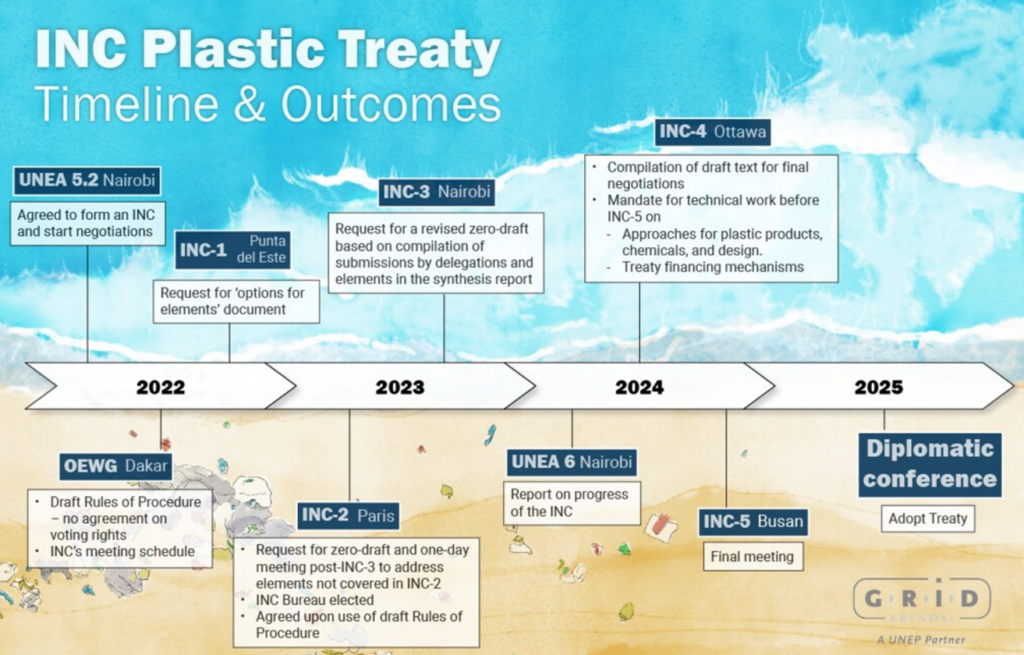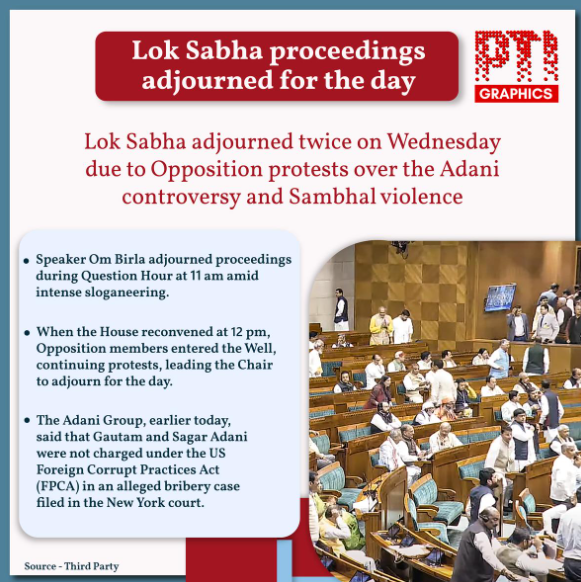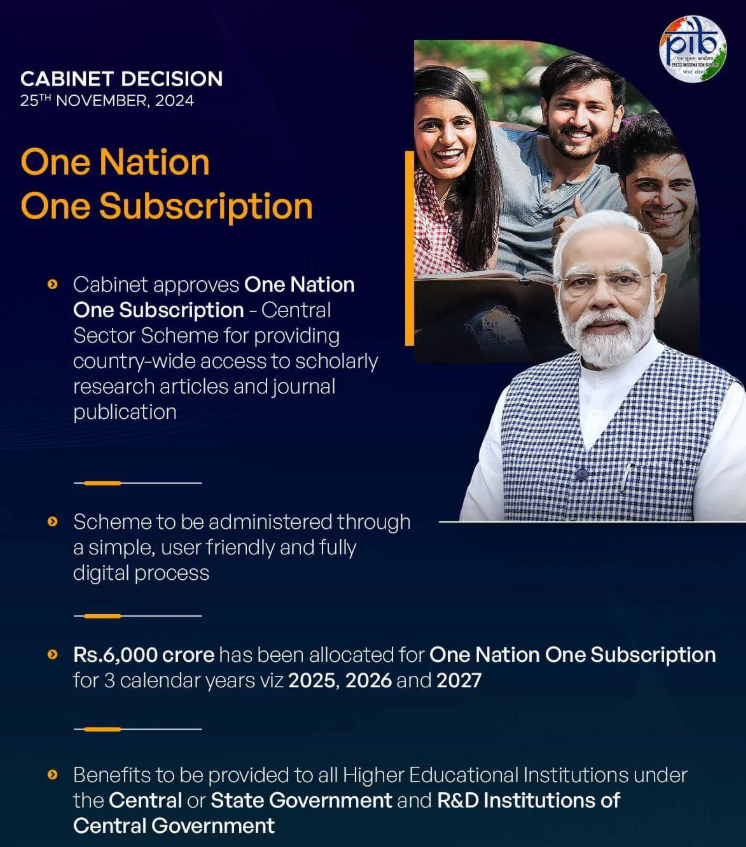28 November 2024 : Daily Current Affairs
1. At treaty negotiations in Busan, India proposes compensation to meet costs of controlling plastics
(Source – The Hindu, International Edition – Page No. – 1)
| Context |
|

India’s Stand at Global Plastics Treaty Negotiations
- India proposed that developing countries comply with ‘control measures’ on plastics only if compensated for associated costs.
- The proposal emphasizes technology transfer from developed to developing nations while respecting “national circumstances,” echoing principles from climate change negotiations.
- India’s submission is one of the few solo proposals, focusing on finance mechanisms and calling for a dedicated multilateral fund.
| Unresolved Definitions and Contentious Issues |
|
India’s Formal Proposals
- India proposed the creation of a multilateral fund, governed by a subsidiary body, to facilitate technology transfer for sustainable plastic production.
- It stressed inclusivity, transparency, and consensus in decision-making, advocating for sustainable transitions under national circumstances.
Diverging Country Positions
- Plastic-producing nations, including Saudi Arabia, oppose limits on plastic production, citing economic disruptions.
- Pacific island nations like Tuvalu and Fiji demand stricter action, citing existential threats from marine plastic pollution.
- Norway, Rwanda, 66 other countries, and the EU advocate addressing plastic design, production, and end-of-life management.
Key Issues Under Debate
- Negotiators must decide on limiting single-use plastics, reducing hazardous chemicals, and the extent of enforceable mandates.
- Common agreement exists on redesigning plastic products for recycling, better waste management, and helping waste pickers transition to safer jobs.
Civil Society and Industry Perspectives
- Environmental groups, such as Greenpeace, demand measures to reduce plastic production, eliminate toxic chemicals, and ensure a non-toxic, sustainable future.
- Industry leaders support policies that promote plastics’ benefits while ensuring sustainable recycling and pollution prevention.
- They stress the need for practical, implementable, and globally harmonized policies to address the plastic crisis.
Conclusion
- The treaty negotiations face challenges of balancing environmental concerns with economic interests.
- A consensus-driven, inclusive approach with adequate funding and technology transfer is critical for meaningful progress.
- The treaty represents a pivotal moment to create a sustainable, non-toxic future while addressing the global plastic pollution crisis.
| Practice Question: Discuss the significance of the Global Plastics Treaty in addressing the global plastic pollution crisis. Examine India’s proposals at the treaty negotiations and their implications for balancing environmental and economic priorities in developing countries. (150 Words /10 marks) |
2. Amid protests by Opposition, both Houses adjourned again
(Source – The Hindu, International Edition – Page No. – 5)
| Context |
|

What Is Adjournment?
- Adjournment refers to the suspension of a parliamentary sitting to resume at a later time or date.
- It is typically done for a break, or when proceedings need to be paused due to disruptions or other reasons.
- The Speaker or Chairman of the House announces the adjournment.
- It can be temporary, to resume on the same day, or for a longer period.
- Adjournment does not end the session but pauses it.
Similar Terms:
- Session
- A defined period when Parliament convenes to carry out legislative and other duties.
- A session includes multiple sittings, separated by adjournments, and ends with prorogation or dissolution.
- Prorogation
- Marks the formal end of a parliamentary session by the President on the advice of the Council of Ministers.
- All pending bills and motions lapse unless carried over, except those in a joint committee or referred for consideration.
- No further meetings of the House occur until the next session is summoned.
- Adjournment Sine Die
- Indicates the adjournment of a House without setting a date or time for its next sitting.
- Effectively suspends parliamentary business indefinitely until the Speaker or Chairman summons the House again.
- Dissolution
- Exclusively applicable to the Lok Sabha, it ends the House’s tenure either on completing its term or earlier by the President’s decision.
- Requires fresh elections to form a new Lok Sabha, and all pending bills, except financial ones, lapse.
- Postponement
- Refers to delaying the consideration of specific bills, motions, or discussions to a later time or date within the same session.
- Maintains the subject’s relevance without allowing it to lapse.
| Practice Question: Explain various terms in parliamentary procedures, such as prorogation, adjournment sine die, suspension of sitting, and dissolution. Discuss their significance in the context of legislative functioning and the continuity of parliamentary business. (250 Words /15 marks) |
3. What is One Nation One Subscription’ initiative?
(Source: Indian Express; Section: Explained; Page: 16)
| Topic: GS2 – Governance |
| Context: |
|
Analysis of News:

Introduction of ONOS Initiative
- The Union Cabinet has approved the “One Nation One Subscription” (ONOS) scheme with a budgetary allocation of ₹6,000 crore.
- This initiative aims to centralise journal subscriptions and provide equitable access to academic resources for India’s higher education institutions (HEIs), benefiting research and education.
Existing Journal Access System
- HEIs currently access journals through 10 separate library consortia under various ministries and individual subscriptions.
- For example, the INFLIBNET Centre oversees the UGC-Infonet Digital Library Consortium, granting access to select journals.
- Approximately 2,500 HEIs collectively access 8,100 journals through these fragmented systems.
Key Features of the ONOS Scheme
- ONOS seeks to integrate journal access for 6,300 government-run institutions under a single platform operational from January 1, 2025.
- The platform will provide access to 13,000 journals from 30 renowned international publishers, including Elsevier, Springer Nature, Wiley, Taylor & Francis, IEEE, and others.
- INFLIBNET has been designated as the implementing agency, ensuring a streamlined registration and access process for institutions.
Financial Planning and Cost Efficiency
- The central government has negotiated significant cost reductions, bringing the annual subscription cost from ₹4,000 crore to ₹1,800 crore for 13,000 journals.
- The ₹6,000 crore funding will cover subscriptions for three calendar years (2025-2027).
- Institutions desiring additional journals beyond the platform’s offerings can subscribe to them independently.
Benefits of the ONOS Initiative:
- Increased Access: Extends access to high-quality journals for nearly 1.8 crore students, faculty, and researchers across government universities, colleges, research bodies, and Institutions of National Importance (INIs).
- Cost Savings: Avoids duplication of journal subscriptions, thereby eliminating redundant expenditure.
- Enhanced Bargaining Power: A unified subscription model provides better leverage in negotiations with publishers, ensuring affordability.
- Data Insights and Utilisation: Enables the government to track journal usage, promoting efficient resource utilisation and encouraging underperforming institutions to engage more with the platform.
Rationale for ONOS
- The initiative aligns with the National Education Policy (NEP) 2020, which emphasises the need for robust research infrastructure to position India as a global knowledge hub.
- NEP 2020 recommended the establishment of a National Research Foundation (NRF) to foster innovation and research excellence. ONOS supports this vision by enhancing access to scholarly resources.
Development and Implementation
- In 2022, the government formed a core committee of secretaries chaired by the Principal Scientific Advisor, followed by a cost negotiation panel to streamline discussions with journal publishers.
- The Anusandhan National Research Foundation (ANRF) was also established in early 2024 to strengthen research and development.
Way Forward
- The government plans to negotiate Article Processing Charges (APCs) with publishers to reduce costs for publishing research papers. APCs are fees authors pay for publishing in open-access journals.
- Subject-specific expert groups will facilitate these negotiations to ensure affordability for Indian researchers.
- A decision on whether to extend the ONOS benefits to private HEIs is still pending.
Conclusion
The ONOS initiative is a transformative step towards democratising access to academic resources, reducing redundancies, and fostering a research-oriented ecosystem across India’s HEIs. It promises to streamline costs, expand accessibility, and significantly boost research and innovation in the country.
Prelims Facts
1. New moiré superconductor opens the door to new quantum materials
(Source – The Hindu, International Edition – Page No. – 7)
| Context |
|
As this example of screen-printing shows, a moiré pattern emerges when two layers, one with red circles and one with black circles, are overlaid and one layer is twisted by a small angle.
Introduction to Moiré Materials
- Moiré materials are formed by stacking two layers of 2D materials, such as graphene, and twisting one layer slightly.
- These materials exhibit exotic electronic and quantum properties, including superconductivity.
Semiconductor Moiré Materials and Superconductivity
- Recent studies in Nature report that moiré materials made from semiconductors like twisted bilayer tungsten diselenide (tWSe₂) can also exhibit superconductivity.
- This discovery challenges the prior belief that superconductivity in moiré materials is exclusive to graphene.
Moiré Pattern and Flat Bands
- The twist between layers creates a moiré pattern, altering the material’s electronic structure and forming flat bands.
- Flat bands lead to uniform electron energies, fostering strong electron-electron interactions and the formation of Cooper pairs, essential for superconductivity.
| Key Findings on tWSe₂ |
|
Implications
- The study highlights the stability of tWSe₂’s superconducting state and its potential for exploring semiconductor-based superconductors.
- It provides insights into the effects of twisting 2D layers on electronic structure and superconductivity.
2. Indian Chemical Council Wins 2024 OPCW-The Hague Award
(Source – https://pib.gov.in/PressReleseDetail.aspx?PRID=2077867®=3&lang=1 )
| Context |
|
OPCW The Hague Award:
- The OPCW The Hague Award was established in 2014 by the Organisation for the Prohibition of Chemical Weapons (OPCW) and the Municipality of The Hague.
- The award recognizes individuals and organizations that significantly contribute to the goals of the Chemical Weapons Convention (CWC), which aims for a world free of chemical weapons.
- It is presented annually during the Conference of the States Parties (CSP) to the CWC.
- The award highlights the role of organizations or individuals in advancing the implementation of the CWC, promoting chemical safety, and enhancing industry security.
- The 2024 award was conferred upon the Indian Chemical Council (ICC) for its contributions to chemical safety and compliance in India’s chemical industry.
| Organisation for the Prohibition of Chemical Weapons: |
|


